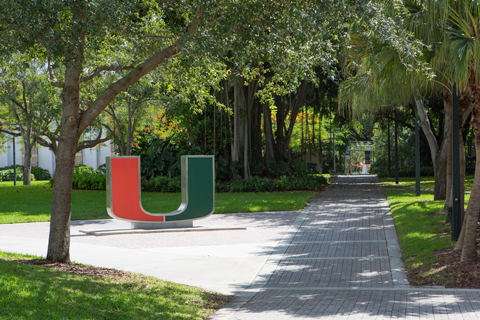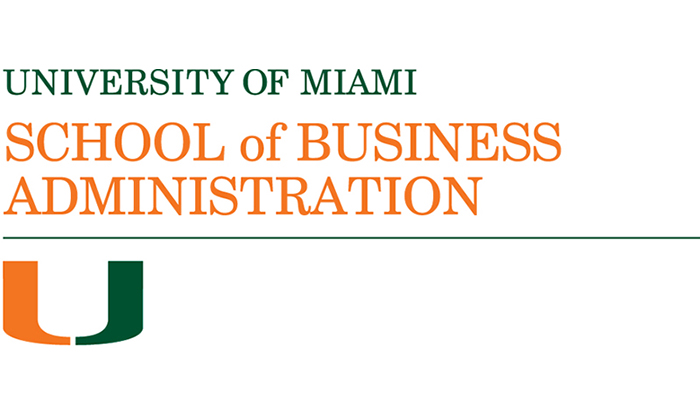Liaison International’s Bob Alig recently spoke with Loubna Bouamane, Ph.D. director of admissions for graduate business programs at the University of Miami, about how her school incorporates technology into the recruiting process — and why the University of Miami has found technology and creativity vital in maintaining a steady pipeline of international applicants.

Bob Alig (BA), Liaison: There’s a clear undercurrent in the initiatives of your dean, Dr. John Quelch, and the University of Miami Business School around embracing technology. You’re really on the cutting edge — you’re trying new things, you have the courage to make mistakes and learn along the way. Tell us a little more about that culture, why it appeals to you and maybe even what brought you to the University of Miami in the first place.
Loubna Bouamane (LB), University of Miami: I’ve been with the University of Miami for three years now as the Director of Admissions. I take care of the full-time program and the specialized master’s. We have another director who manages all the executive programs and the professional MBA.
To answer your question about technology, the University of Miami has taken a global approach to education from the very beginning. We have very diverse classrooms — our reach goes far beyond geographic area, and technology plays a critical part in that outreach. Dr. Quelch has been a dean on three different continents, so he’s really bringing a global approach to business education.
Technology is not just in our recruiting and admissions; it’s also in the classroom. For example, our faculty were among the first to incorporate innovative technology into their teaching. We use artificial intelligence, gaming, simulations and virtual reality. The goal is to train our students to get lifelong learning and to succeed in this labor market that sometimes requires very advanced technological skills.
Getting back to recruiting and admissions, we were looking for a way to differentiate ourselves by integrating social media and technology into the way we interact with prospective students. They want to have access to information at their own pace, usually as fast as possible. We concentrated on making information readily available and making the admissions team as accessible as possible.

To give you an example of some of the tools that we use in the recruiting process, we offer a virtual campus tour with a 360-degree view of the campus. Students can select different buildings, look inside, go inside the library — all from their own computers! It helps them get a feel for what the campus is like, and what the atmosphere is like. We also host virtual info sessions and chats — this brings personal attention and helps students get the answers they need to evaluate our program without having to come to campus and meet face to face with an admissions officer. This is really important for people who are far away.
For example, in China, they have very limited access to social media, and they use WeChat. So, we created a chat room in WeChat to interact with prospects and currently admitted students. We send them updates on where they stand in terms of the admissions process, for example, the I-20 student visa. Another thing, we started doing virtual interviews early on. A lot of our students are far away from Miami. Phone interviews are great, but they lack the sense of personal connection you can get with video when you can actually see the person. We made the interview a critical part of the admissions process because that’s when you get to establish contact with the candidate, learn their goals and have a discussion about what they’re trying to achieve. We can make sure we’re setting them up with the best program to help them achieve their goals. The overwhelming majority of our interviews are conducted online.
We’re very active on social media — I think most schools are now, but we’ve been active for a long time. You can learn everything about the University of Miami on Facebook, on Twitter and we also have an Instagram account. Once we admit a student, we invite them to join a private Facebook group where they have access to a message board and can make connections with classmates directly. They can find students from the same areas, people with common interests — this creates a sense of community before they’re even on campus. It really has an impact on the number of students who accept the offer. Creating that sense of community early on is critical.
BA: That’s incredible — I love to hear the passion and enthusiasm in your voice — so palpable. Social media is so important and connecting with people where they are is powerful. This is truly an international MBA program that happens to be located in the U.S., and I think that sets you apart. This dovetails beautifully as you’re one of the first five global institutions to adopt BusinessCAS™, and to partner with us at Liaison as a member of the BusinessCAS advisory board. Can you give us a little perspective on those decisions and how our work together is evolving?
LB: Sure. We really leapfrogged into the use of technology early on, especially in the recruiting process, so the next step for us was to apply technology to the way we process our admissions files. We were using a different method and looking for a way to make the application process as smooth and seamless as possible. We had established a good method for recruiting, where our interactions with students and prospects were easy, so we really needed to bring that seamlessness to the admissions process. That’s why our leaders went looking for ways to make this better, and that’s where BusinessCAS came in. We saw the Centralized Application Service as a great an opportunity to create the best experience possible for our applicants.
BA: And how has it been for you to communicate this change with your staff, your faculty, with your colleagues? Sometimes people are apprehensive of being first — they want to wait until 20 other schools have done it. You’re obviously showing some courage to be among the first.
LB: We’ve been very entrepreneurial at the University of Miami, especially the Business School. We have great leadership that gives us the freedom to think outside the box. We all knew, from the recruiting team all the way to the deans, that we were doing great when it comes to recruiting, but there was room for improvement around the process. We didn’t get pushback, everyone was willing to try. We’re very confident it will greatly help us with our application process; there was no doubt in anyone’s mind that this was the right time to jump in and try.
From the very beginning, we’ve had all the support we could possibly need. Now we’re in the stage where we’re working internally with our IT team to create an integration between Peoplesoft and BusinessCAS. I have to commend Liaison and its team, especially Karen Jacobs [Liaison’s Vice President of Client Success].
BA: That’s terrific; it’s so good to hear that. I’m not surprised, but it’s good to hear that. So, you’re wrapping up this year’s admissions cycle and planning for next year. What are some of the stressors that you’re currently feeling?
LB: When I think about it, in admissions we’re the first point of contact for prospective students, so it’s on us to offer top-notch customer service. From March all the way through early May is really the busiest time in terms of processing applications. We’re mostly done with the bulk of the recruiting process, even though it’s never really done, but now the bulk of our focus is on getting through the pipeline, issuing decisions. The big challenge is really offering personalized connections with students while still processing applications. That’s not an easy task. That’s where we’re hoping BusinessCAS can help, by allowing us to be more hands-off in the processing of applications so we can focus on counseling, recruiting and offering a personalized service to our students.
BA: It’s interesting because while you were talking, I thought back to my own experience at Wharton. It might sound ridiculous, but I always cared very deeply how the students who were not admitted felt about the process because they never got a chance to form another impression of Wharton. If they felt like they were treated fairly, if they had had a chance to put their best foot forward, then they would be a part of communicating the message of Wharton going forward — they could be a positive force or a negative force.
LB: That’s our biggest concern: We have a limited staff, and it’s tough to prioritize students who are calling or walking in. You want to give them the attention they deserve and update them on their application or give them information about the program they might be interested in, but when you have a stack of files that you need to process and decisions that you need to issue, it can be a challenge at times.
BA: Right. So, you’ve had a little more exposure to BusinessCAS, you’re actually living and breathing the implementation as we speak. Are there new ways you think BusinessCAS is going to be able to support you in your efforts to engage a prospective student and help communicate the message of the University of Miami better?
LB: All of the information about our programs will be centralized in one spot. It will create visibility — we’ll be right there in the marketplace with other schools. Students who have already compiled the documents for applying to an MBA program will have us at their fingertips. All they have to do is select the university, look through our programs, check the requirements and click submit. It will make the process much easier for them and at the same time increase our visibility. I don’t really see it as being in competition with other schools, I think it’s quite the contrary, we’re just making things easier for prospects. That’s a great place to be. Everything has been seamless. The system is really intuitive and easy to use from both the student and admissions perspectives.
BA: I’d like to refer to a recent Poets&Quants article, which mentioned that the number of new international enrollees in U.S. universities declined for the first time in 12 years in 2017 and that graduate business programs’ numbers have gone flat. Can you tell us a little bit more about the trends you are seeing in international students at the University of Miami?
LB: It’s interesting because we’re experiencing quite the opposite. At the University of Miami, the number of international students has been steadily increasing over the past few years. We’re seeing interest in our specialized master’s programs, such as our finance program or business analytics, as well as our MBA program. I don’t know if that result is because we were expecting numbers to decline so we were a little more aggressive in our international recruiting efforts. I’m happy to say we’re having a very notable increase in the number of international applications, especially from China and several countries in Latin America.
BA: That’s fantastic. I think that’s just such an affirmation of all the hard work you and your team have been doing and the vision of your dean to think much more broadly. Have you done anything differently in the last couple of years?
LB: We’ve been experimenting with different things to try to increase diversity in the classroom. I started doing webinars and scheduled them at times that fit for people in China, Europe and Latin America, and I was surprised to see the number of people who registered and are interested in learning about our programs.
Another thing we started doing is renting shared workspaces — we have one here that’s called Pipeline and another called WeWork. They’re everywhere in the U.S. and have some locations in Latin America, so we’re looking to go to these locations especially in Latin America, Mexico and Brazil to rent space and host day-long info sessions. That’s helped us put our programs out there and recruit in these countries. We also purchase lists of GMAT test-takers globally, which is also a great way to focus recruitment and let students know about the programs we offer.

BA: I had never thought of it before, but I’m doing work with a small consortium of volunteers to help startups in the Philadelphia area, and they have their monthly meetings at WeWork. I’m visiting WeWork on a monthly basis as part of this volunteer work, and I’m blown away by the buzz and the energy. That’s perfect, what a great idea.
LB: Pipeline is similar, and we realized that these workspaces are often in convenient locations, either downtown or close to financial districts. It makes it easy for students to come in during lunch without having to come to our campus. We try to be as mobile as possible and meet our prospective students where they are.
BA: Let me pivot a little bit to our next question — across higher ed the number of students over age 35 is expected to comprise about 19% of the total graduation pool by 2020: What trends are you seeing in the age of your applicants? And perhaps in a more general sense, are you satisfied with the diversity in your applicant pool? Are you considering any changes along those lines?
LB: We’re always striving for more diversity. We’re in Miami, which is one of the most diverse cities in the country, and we really want our classrooms to reflect that diversity. Not just in terms of cultural background or citizenship, but in terms of academic or professional background. For example, we’re seeing a surge of people who come to us with 10 years of work experience and are wanting to further their education with either a professional MBA or a specialized master’s.
A few years back the majority of the people who would go for a specialized master’s were young people who had just gotten a bachelor’s degree that didn’t necessarily want to take time off to go work somewhere then come back and further their education. They just wanted to get it done once and for all, but this is changing. Now we’re seeing people who work for several years, and they’re hearing about the specialized master’s programs that are becoming more popular, especially among employers. They come, investigate and think, if I spend a year going back to school, I can get this master’s degree and I can switch careers. We’re seeing a trend where people who are very experienced are coming back for master’s degrees. Some of them are career switchers, some of them realize they no longer like the place where they work and they want to learn a new industry, and they realize the master’s is a great fit for them.
BA: Excellent. Very helpful. Building on that, can you share a little more about how you believe your use of BusinessCAS will help you with the diversification of your applicant pool?
LB: As I mentioned previously, we always try to use technology to help us in our recruiting efforts. I think being part of a marketplace like BusinessCAS allows us to have basically a storefront, and students who may not have considered the University of Miami see us and discover one of our programs is a good fit for them. It definitely helps in terms of exposure and accessibility as now students don’t have to look up schools individually, they can go to one place and research different schools and programs. We’re getting a sense that this younger generation is looking for easy access to information; that’s really how we saw BusinessCAS — as an opportunity for us to be easily searchable and easily discovered.
BA: What can you share about your planning for next year?
LB: I’m not really worried about the trending decline in international applicants, especially with younger people, and we found that especially with our specialized master’s programs, we never heard any concerns about the possibility of getting a student visa or finding a job afterward. It’s also our job as recruiters and admissions directors to have conversations with international students to tell them what to expect. I think if they feel like they’re going to join an environment that will be welcoming, I don’t think they will change their minds about attending a school in the U.S.
We try to reach out in many ways, as many ways as possible, to international students and hopefully that will keep the number coming in steady. Again, technology makes it so easy to connect with people wherever they are and it is so easy to share information. It’s really up to us as admissions staff at business schools to reach out. People are there just looking for information, and it’s up to us to make it as readily available as possible.
I hear all the time from candidates who are debating between two schools who end up coming here to Miami. They tell us the difference was not so much the rankings or the courses or the length of the program, it’s that relationship they had with people in the admissions office, and they feel like, “This is the type of environment where I’ll feel welcome.”
BA: Is there anything else you’d like to share with us?
LB: I just want to say that I’m very thankful to be part of the [BusinessCAS] advisory board. As an admissions director, it’s rare to get the opportunity to sit down and be in the same room with other admissions leaders from other institutions, to get to share best practices. It’s a great opportunity to be a collaborative member in the business school community, which we rarely get outside of conferences — being assembled together for an entire day, getting the chance to discuss our challenges and how we can work together is great, and I’m very thankful for that.
BA: Frankly that’s been one of the most wonderful things about my work at Liaison — I hope it’s clear that I get a lot of satisfaction from bringing the group together. Everybody wins, and ultimately global grad education management benefits.
If you’re exploring ways to extend your program’s reach and connect with a larger pool of qualified applicants, BusinessCAS may be able to help. Learn more about the power of the BusinessCAS marketplace at businesscas.org.
